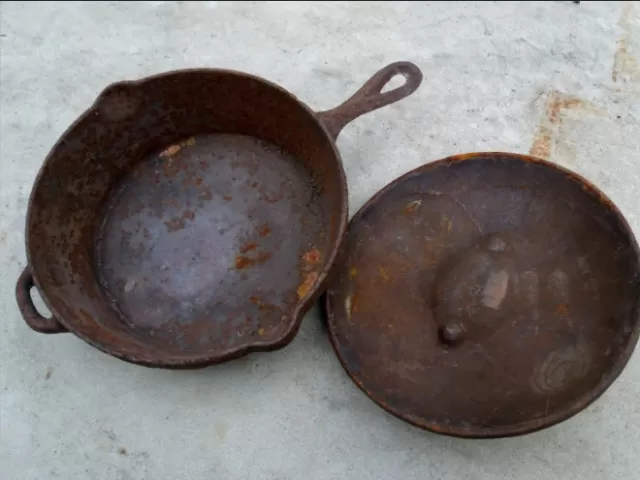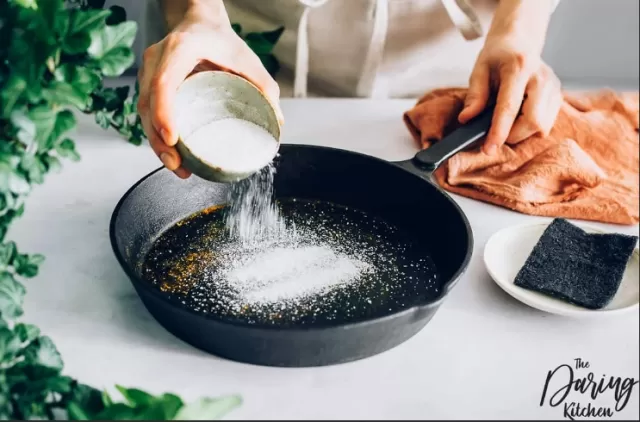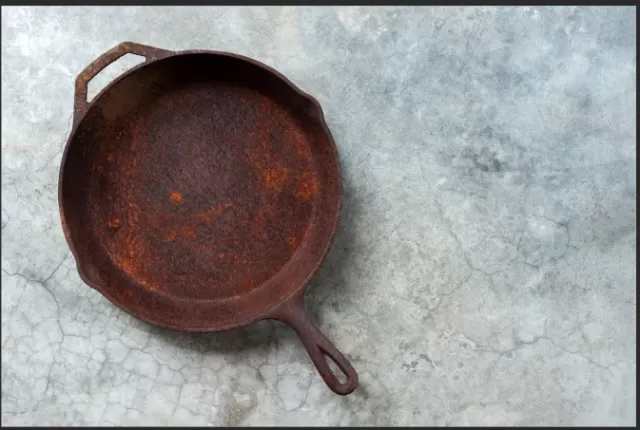Proper Techniques for Cleaning a Rusty Cast-Iron Skillet. While a cast-iron skillet is a durable kitchen essential, its longevity can be compromised if rust develops. Fortunately, with the right Cleaning Tools and method, you can salvage your cast iron even when rust has built up. Here’s A Step-By-Step guide to restoring your cast-iron skillet:
Materials Needed:
Steel Wool or Scrubber: Choose a fine-grade steel wool or scrubber to effectively remove rust without damaging the skillet’s surface.
Dish Soap: Opt for a mild dish soap that won’t strip away the skillet’s seasoning.
White Vinegar: An excellent rust remover, white vinegar helps break down rust without harsh chemicals.
baking soda: This natural abrasive can aid in scrubbing away rust.
Step-by-Step Process:
Inspect the Rust:
Examine the skillet to assess the extent of the rust buildup. Minor rust spots can often be easily addressed.
Scrub with Steel Wool:
Use a fine-grade steel wool or scrubber to gently scrub away the rust. Apply moderate pressure and work in circular motions.
Wash with Mild Soap:
Wash the skillet using a mild dish soap to remove any remaining rust particles. This step ensures a clean surface for the next stage.
White Vinegar Soak:
If the rust persists, create a solution of equal parts white vinegar and water. Submerge the skillet in this solution and let it soak for several hours or overnight.
Scrub Again:
After soaking, scrub the skillet once more with steel wool or a scrubber. The vinegar will have loosened the rust, making it easier to remove.
Rinse and Dry:
Thoroughly rinse the skillet with water and dry it immediately. Avoid leaving it damp, as this can lead to future rusting.
Season the Skillet:
To restore the protective seasoning, apply a thin layer of oil to the skillet’s surface and bake it in the oven at a high temperature.
By following these steps, you can effectively salvage a rusty cast-iron skillet and continue to enjoy its durability and cooking benefits for generations to come. Regular maintenance and proper seasoning will help prevent future rusting.
Understanding the Rust Formation in Cast-Iron Pans

The emergence of rust on cast-iron pans can be attributed to prolonged exposure to both moisture and oxygen.
According to Alicia Sokolowski, President and co-CEO of AspenClean, the susceptibility of the metal to oxidation is A Key factor in the development of rust on cast iron. This vulnerability is exacerbated by the porous nature of cast iron.
For instance, if the pan is left to soak, placed in the dishwasher, or not adequately dried after washing, it becomes more prone to rust formation. Delving into the intricacies of why and how cast-iron pans succumb to rust offers valuable insights into proper maintenance practices for these kitchen essentials.
Essential Materials for Cleaning Rusty Cast-Iron Items

Ensure you are well-prepared with the following materials for the effective cleaning of a rusty cast-iron item:
Steel Wool or Stiff Brush:
Use steel wool or a sturdy brush to scrub away rust and stubborn residues from the surface of the cast-iron item.
Natural Dish Soap:
Opt for a natural dish soap to gently clean the cast iron without introducing harsh chemicals.
This helps maintain the seasoning of the pan. White Vinegar:
White vinegar serves as an excellent rust remover.
Its acidic properties assist in breaking down rust, making it easier to clean and restore the cast-iron item. Baking Soda:.
Baking soda acts as a mild abrasive and can enhance the cleaning process.
It helps lift stubborn rust and grime without damaging the cast iron’s surface. Kitchen Towel:.
Keep a kitchen towel handy for drying the cast-iron item thoroughly after cleaning.
Proper drying is crucial to prevent the formation of new rust. Having these materials readily available ensures a thorough and effective cleaning process, promoting the longevity and optimal performance of your cast-iron cookware.
Step-by-Step Guide on Cleaning a Rusty Cast-Iron Pan and Re-Seasoning:
Assess and Remove Loose Rust:.
Begin by using steel wool or a stiff brush to eliminate any loose rust.
This initial step is crucial in preventing further corrosion.
Wash with Natural Dish Soap (if necessary):
If the cast-iron pan is particularly soiled, wash it with natural dish soap and warm water.
Be cautious not to use dish soap too frequently, as it may strip away the pan’s seasoning.
Prepare White Vinegar Soak:.
Fill the sink with an equal mixture of white vinegar and water.
Submerge the pan in this solution, allowing it to soak for 30 minutes to an hour. Avoid prolonged soaking, as it can affect the integrity of the pan.
Scrub with Steel Wool or Brush After Soaking:
Following the vinegar soak, use steel wool or a brush to scrub the skillet once again.
The vinegar helps break down the rust, facilitating its removal.
Address Persistent Rust Spots with Baking Soda Paste:
For stubborn rust spots, create a paste by mixing baking soda with a small amount of water.
Apply the paste to the affected areas and scrub with steel wool or a brush.
Thoroughly Rinse the Skillet:
Rinse the cast-iron pan thoroughly with water to eliminate any residual vinegar or baking soda.
Dry Completely:
Use a kitchen towel to ensure the skillet is dried completely.
Proper drying is crucial to prevent the onset of new rust.
Re-Season Your Cast-Iron Skillet:
After cleaning, it’s essential to re-season the cast-iron skillet.
Apply a thin layer of cooking oil to the surface and place the skillet upside down in an oven preheated to around 450 degrees Fahrenheit for an hour. This process creates a protective, nonstick layer on the cast iron.
By following these steps, you not only remove rust from your cast-iron pan but also ensure its longevity and optimal cooking performance through the re-seasoning process.
Tips for Preventing Rust on Cast Iron

Season Your Cast-Iron Skillet:
After thorough cleaning, it’s crucial to season your cast-iron skillet.
Seasoning creates a protective layer that shields the surface from direct exposure to oxygen and moisture, preventing rust formation.
Be Cautious with Acidic Foods:
Exercise caution when cooking acidic foods in a cast-iron skillet, as these ingredients can strip away the seasoning and increase the likelihood of rusting.
Consider using alternative cookware for acidic dishes.
Avoid Dishwasher Use:
Never put your cast-iron cookware in the dishwasher.
The harsh conditions can lead to rusting. Opt for handwashing with gentle cleaning methods to preserve the skillet’s integrity.
Use Dish Soap Moderately:
When cleaning cast iron, use dish soap in moderation.
Excessive use can strip away the seasoning, making the skillet more susceptible to rust. Choose natural and mild dish soaps to maintain the protective layer.
Regularly Use Your Cast Iron:
Regular use of your cast-iron skillet contributes to the maintenance of its seasoning.
The natural oils from the food create and enhance the protective layer on the surface, making the pan more resistant to rust over time.
By incorporating these preventive measures into your cast-iron care routine, you can ensure the longevity and rust-resistant properties of your cookware.
Proper maintenance not only enhances the performance of your cast iron but also preserves its unique cooking qualities.
*The information is for reference only.